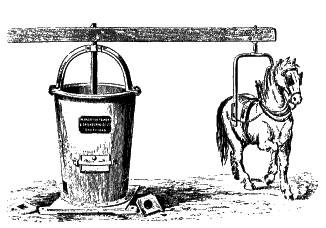The Brickmakers of St
Albans
A Talk given to the St Albans & Hertfordshire
Architectural & Archaeological Society at St Albans on 7th January 2003

Excavating the brick earth and taking it to the pug mill
The Brickmakers of St Albans
Making Hand-made Bricks ...
A Talk given to the St Albans & Hertfordshire Architectural & Archaeological Society at St Albans on 7th January 2003

Excavating the brick earth and taking it to the pug mill

A Pug Mill
| < Previous | Foil 15 | Next > |
| Index |
Supplementary Information
The following information comes from The National Encyclopædia, William Mackenzie, London, circa 1864
In making ordinary English bricks, the top soil, or encallow, is first removed from the clay, which is dug and turned over in the winter. Exposure to wet and frost prepares it for use by the spring, when fine ashes are added to it in the proportion of one-fifth ashes to four-fifths clay, or 60 chaldrons to 240 cubic yards, which will make 100,000 bricks. … The clay and ashes being well mixed by digging, watering, and raking backwards and forwards with a pronged hoe, the mass is removed in barrows to the pug-mill, which consists of an upright barrel in which a series of strong iron knives and teeth are caused to revolve by the power of a horse walking in a circular path, so as to cut and masticate the clay very thoroughly as it passes from the top of the barrel to an aperture provided for the exit at the bottom. As the clay oozes out of the mill, it is removed with a cuckhold, or convex shovel, and covered with sacks to prevent it drying too fast. A person called the feeder takes from the stock of clay thus prepared a piece about the size of a brick, covers it with sand, and passes it to the moulder, who throws it with some force into a wooded mould, of the size and shape of the brick, which mould is previously sanded. Having filled the mould, the moulder cuts off any superfluous clay with a stick kept in a bowl of water by his side, and then removes the back and sides of the mould, after which the soft brick is carefully transferred from the bottom board of the mould to the pallet-board, and, when a sufficient number have been moulded, is conveyed with others to the hacks, which are long level lines raised about 4 inches from the surface of the field, and formed about 2 feet 6 inches wide. The upper surfaces of the bricks are previously sanded, and great care is taken to avoid twisting or otherwise injuring their shape in transferring them to the hacks, on which they are laid in two rows, with a little space between each to allow the free circulation of air. When partially dried, the bricks are removed, placed diagonally, with wider apertures, and with the bottom bricks brought to the top; and after this process, which is called skintling, they are removed to the kiln or clamp, which is a vast pile of bricks, laid together as closely as possible, on a slightly concave foundation of brick rubbish, the raised ends of which face the north and south. On this foundation the new bricks are built up in lots of necks, of which the centre one, which is the first erected, is vertical, while the others, owing to the concavity of the foundation, have a slight inclination towards it. Small spaces filled with breeze, are left among the lowest courses of bricks, and flues or live-holes, about the width of a brick, and from six to nine feet apart, are also formed to aid the lighting of the clamp, and filled with dry bavins or wood. When full, the clamp is surrounded by old bricks, or by the driest of those newly made, and a thick layer of breeze is spread on the top. The external bricks are coated with a thin plastering of clay; and, if the weather proves wet, the kiln is protected by loos, or hurdles interwoven with rushes. The fire is lighted at the mouths of the flues or live-holes, which are closed when it burns well; and in favourable weather the bricks will be completely burnt in about twenty-five or thirty days, in the course of which time the cindery matter dispersed through their substance becomes gradually ignited and consumed. Such bricks as are found to be imperfectly burnt are put into the next clamp to be burned again. Those which are sufficiently burnt are separated, according to quality, into - hard sound stocks, or inferior soft red bricks; and burrs, or clinkers, which are black-looking masses of vitrified brick, of very inferior value.
If you can add to the information given above tell me.